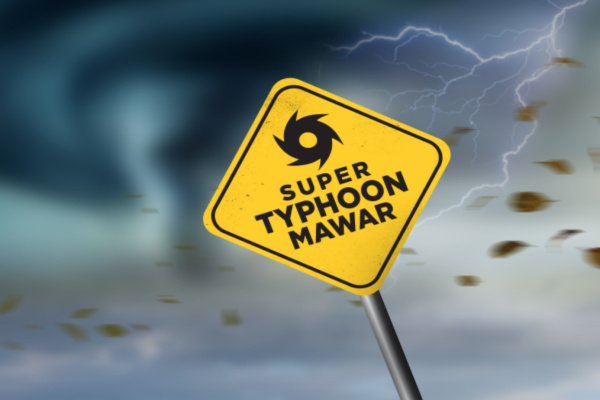Typhoon Mawar, which snapped trees and damaged buildings in Guam last week, was continuing its trek northwest across the Philippine Sea late Monday and is expected to bring heavy rain and gusty winds to portions of the Philippines, Taiwan and Japan this week, according to AccuWeather forecasters.
Ahead of the expected impacts, officials in the northern Philippines ordered the evacuation of thousands of people on Monday, while businesses and schools were shuttered, according to The Associated Press (AP). Meanwhile, well ahead of the storm, rough seas generated by Mawar swept four people out to sea along the eastern coast of Taiwan on Sunday, with one person reported dead, according to Taiwan News.
As of late Monday evening, local time, Mawar — known as Betty in the Philippines — was still packing maximum sustained winds equivalent to that of a major Category 3 hurricane (111 to 129 mph, or 178-208 km/h) on the Saffir-Simpson Hurricane Wind Scale. It was located several hundred miles to the east-northeast of Luzon, the northernmost island in the Philippines.
According to AccuWeather, Mawar was once an even more powerful typhoon over the open waters of the Philippines Sea, with winds equivalent to that of a Category 5 hurricane (at least 157 mph, or 252 km/h) early this past weekend. That wind intensity made the typhoon the most powerful storm on the planet so far this year.
“Mawar will continue to lose wind intensity slowly over the next few days as it slows and turns northward,” said AccuWeather Lead International Forecaster Jason Nicholls. “An eventual turn to the northeast is expected late this week.”
While Mawar has lost some wind intensity due to “wind shear,” or unfavorable winds in the upper atmosphere working against the typhoon’s forward progress, impacts from strong winds and heavy rain are still anticipated for portions of eastern Asia, according to AccuWeather forecasters. “The outer bands of Mawar will bring rain and wind to northern Luzon into Wednesday,” said Nicholls. “Flooding will be possible due to several days of rain, and gusty winds can also lead to isolated damage along the northern coast.”
“Eastern Taiwan can also have rain and wind impacts from Tuesday into Thursday,” Nicholls added. The island should be spared of the worst impacts since the storm will be curving to the north before reaching the coast. Rainfall is expected to tally 2 to 4 inches (50 to 100 mm) in northern Luzon and Taiwan, with higher amounts possible in localized areas.
Despite slamming Guam with 120-mph (195 km/h) winds and 2 feet of rain last Wednesday, May 24, Mawar has yet to make a direct landfall anywhere along its path. Continuing that somewhat fortunate trend, the typhoon will not make landfall in the Philippines and Taiwan early this week despite coming dangerously close. Japan’s Ryukyu Islands may not be as lucky later this week. “The worst conditions from the storm will affect the southern Ryukyu Islands late Wednesday and Thursday as the center of Mawar makes its closest pass to the islands,” said Nicholls.
For the southern Ryukyu Islands, AccuWeather is forecasting wind gusts of up to 110 mph (177 km/h) and 8 to 16 inches (200 to 400 mm) of rain, along with a Local StormMax™ of 24 inches. Mawar will be rated as a 1 on AccuWeather’s RealImpact Scale.
Flooding rain will be the greatest concern across the northern Ryukyu Islands and the southern Japanese mainland Friday into early next week when the system is expected to lose wind intensity and become a tropical storm (maximum sustained winds of less than 74 mph, or 120 km/h). In addition to flooding downpours and strong winds, the typhoon will produce a storm surge along the eastern coastlines of the Philippines, Taiwan and southern Japan, and there could be landslides in the more mountainous terrain impacted by the storm’s rain.
Ahead of the expected impacts, residents and businesses in the Philippines were preparing. A no-sail ban was in effect for the waters off the northern coasts of the archipelago, and about 4,800 people were being evacuated to emergency shelters in Batanes, Cagayan and other provinces in northern Luzon, according to the AP. “We cannot afford not to prepare because that would potentially mean the loss of lives and major damage,” Vice Gov. Ignacio Villa of Batanes told the AP.
Mawar has already been responsible for the loss of life, as there were two separate incidents of people being swept out to sea on Sunday by strong waves on Taiwan’s eastern coast. In Hualien, a 13-year-old boy was killed after becoming caught in a strong undercurrent, according to Taiwan News, while another boy was rescued by boat. In Yilan, a young girl is still missing while another man was able to swim back to sea.
In Japan, the Japan Meteorological Agency warned on Monday that Okinawa could experience impacts from Mawar of an “extended duration” beginning late in the week.
—
Photo Credit: Conceptual Art / Shutterstock.com
